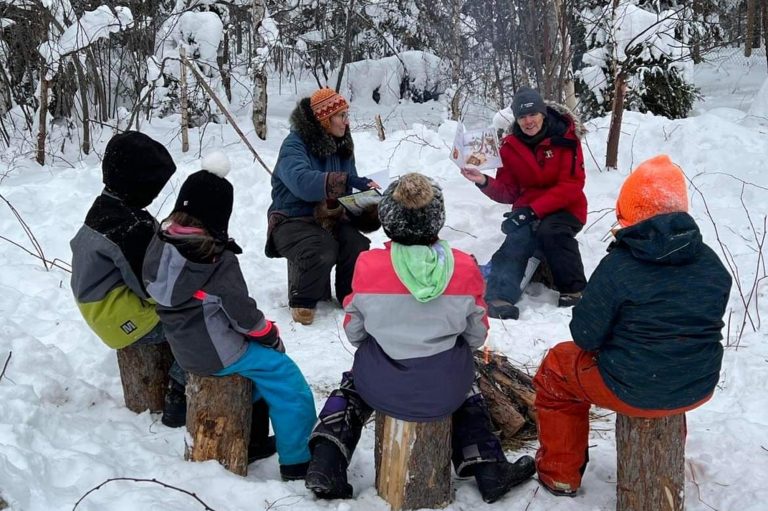
La Ronge authors and Family Literacy Day
Northern Advocate
When the Trees Crackle with Cold – nīhithaw pīsimwasinahikan (a Cree calendar), the Saskatchewan Literacy Network (SLN) chose this children’s book and its authors to celebrate Family Literacy Day, Thurs. Jan. 27. The book fit in with the SLN theme for 2022, The Great Outdoors.
Körner had a fire in her backyard, invited some children she knew, and she and Johnson Laxdal read the book, answered questions and shared stories on a video made for SLN. They answered questions sent in by students from across Saskatchewan and beyond before the event. Students also texted questions as they watched the video and the two authors answered them in and Q&A following the video. More than 16,000 students participated in the event.
Questions ranged from what a smoked fish smells like, to where the two authors lived, where the book was set.
Many, especially from southern Saskatchewan, were surprised to hear they lived in northern Saskatchewan bush country.
The book was written in Cree and English, with the first book in the “y” dialect, which Johnson Laxdal spoke at home. They later published a second edition in the “th” dialect of the Woodland Cree.
Körner, also an artist, made the illustrations that flow through the book enhancing the stories and language.
The book focuses on the six seasons of the year, Winter, Break up, Spring, Summer, Fall and Freeze up.
As part of the publishing process, they held two gatherings with Elders from across Saskatchewan, who perused the book and made changes to reflect their language and culture.
The video is available at saskliteracy.ca on their YouTube page.
Bernice Johnson Laxdal and Miriam Körner met when both working at Pre-Cam Community School in La Ronge.
Körner walked in Johnson Laxdal’s classroom and saw a Cree calendar and noticed the nature-based moon images.
“It made sense to link the moon with nature … I thought it would make an awesome children’s book,” she said.
When she approached Johnson Laxdal, her response – “I always wanted to write a book!”
The two women discovered they both lived at Potato Lake, a community close to La Ronge. They began walking together and the book unfolded from Johnson Laxdal’s stories of growing up in Ile a la Crosse as part of a large family, living outside of town.
“This is just a little snapshot of one winter,” Johnson Laxdal said of the stories relating to the book.
The book focuses on the moon. Each moon has a name in Cree and English. The book focuses on what would have been happening during that month in Johnson Laxdal’s life as a young girl.
For example, kisipisim – Great Moon is the name of the February moon. A time when the bear would be sleeping and the forest silent. As a young child Johnson Laxdal would bring wood into the home to help keep the family warm.
She was one of 14 children. The oldest eight went to the boarding school, while the younger six, of which she was part, walked to school in town one mile away.
Johnson Laxdal remembers walking to school every day except once she caught a ride on a Bombadier.
Families were different when she was growing up, not like the nuclear families today. There was usually an extended family member, a grandmother, great uncle or other relative staying with the family from time to time.
It meant that with her father away on the trapline in the winter, her mother had help at home.
Neither Johnson Laxdal’s parents had an education. Her father attended school for five days and her mother not at all.
“They still taught us what was important and that’s how our family operated. We all sat down at a meal and talked.”
Not having an education didn’t stop her father from running a trapline, fighting wildfires, being a RCMP Special Constable, giving his time to sit on Council and the School Board.
Johnson Laxdal has many stories that could end up in another book one of these days, perhaps.
